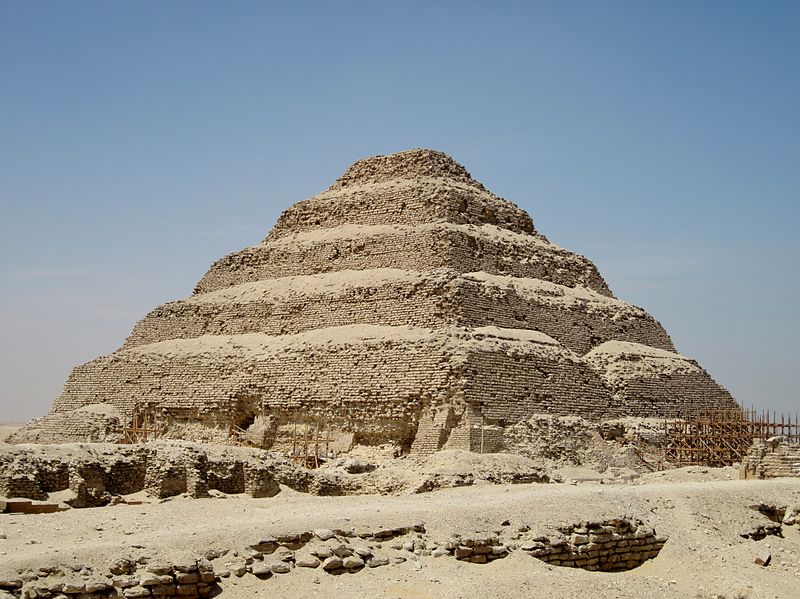When someone thinks of ancient Egypt they cant’s help but picture the pyramids in their minds. The pyramids have been around for so long they are like antiquity personified. They have an enigmatic aura of mystery associated with them: modern governments use the structures as cryptic symbols of stability, and at the same time Hollywood movies portray them as being landing docks for alien space ships. Considering all of this, it’s kind of funny that we actually know a lot about the structures. We even know who invented them! He was an architect, a healer, a politician. He was born a commoner, died a trusted adviser of the king and deified thousands of years after his death. He was a man with a reputation and influence that mirrors the structures he invented. He was Imhotep. In honor of engineer week, we will focus of the first architect/engineer ever mentioned in history, and how his achievements landed him a spot in the hearts of millions.
Imhotep lived during the 27th century BCE. Not a whole lot is known about his personal life, where he was born or if he was married. In fact, he was thought to be a mythological figure until the end of the 19th Century when the deciphering of hieroglyphic monuments confirmed his identity as a true historical figure. He is mentioned prominently at the site of King Djoser’s pyramid at Saqqara. The inscription on a statue of the king there mentions Imhotep and lists several titles including “Chancellor of the King of Lower Egypt, Administrator of the Great Mansion, High Priest of Heliopolis, Chief Sculptor…” he was basically the first architect to be recognized in an official document. If you can call a statue an official document…
Photo courtesy of Wikimedia Commons. Author: Olaf Tausch
Djoser’s pyramid is called the ‘step pyramid’, and it is the oldest known cut stone monument in the world. Until Imhotep came along, Egyptian kings were buried under structures called “mastabas”, which were flat topped piles of mud brick kind of in the shape of a bench. Usually the burial chamber would be underground and the mastaba was a solid structure built on top. There are no documents in existence today that describe Imhotep’s thought process or inspiration, but it seems he simply thought that stacking a bunch of mastabas on top of each other would be really cool, and apparently it impressed Djoser, because up until that point it was unheard of for a pharoh to name another on any of his monuments.
As simple as the concept of the pyramid may sound, the process of actually building the structure was no mean feat. It was necessary to organize large groups of regular citizens to help with this building project of unprecedented scale. Studies of the structure have revealed that the stone blocks were set at an angle pointing slightly inward, toward the center of the pyramid to ensure that the outer shell of the structure wasn’t pulled apart as the edges settled. Some later pyramids have collapsed most likely due to this exact process.
On top of his architectural achievements, Imhotep was also a renowned healer, and a work that is attributed to him is the oldest known document to lay out rational methods of diagnosing and treating injuries and diseases. Dating to an age in which magic was most often used to ward off the evil spiritual influences that were believed to cause disease, the Edwin Smith Papyrus (named after the collector who originally purchased it in 1862) describes 48 injuries and proscribes surgical treatments. It even describes what could be called early brain surgery. It is considered by many to be the most important pre-Greek medical document in existence today.
Edwin Smith Papyrus, image courtesy of Wikimedia Commons
Unfortunately nobody really knows for sure if Imhotep was the original author of the work. The Edwin Smith papyrus was written circa 1600 BC, but it was a copy of a text originally written around the time that Imhotep was alive, so who knows? Imhotep must surely have been a very successful healer, though, because he was deified by the Egyptians around 525 BC. His deified form was associated with healing, and worshipers would leave models of diseased limbs at his temples in the hope of being relieved of their suffering.
Imhotep was a unique individual, the mortal counterpart to his great architectural creation: the pyramid. He represents many things to many people. He is revered by medical students, pondered by historians, appreciated by philosophy students. He is living proof that one individual can have an important and lasting effect to global society. He dared to dream big. And speaking of dreaming big, we have a new Giant Screen film here at HMNS: Dream Big: Engineering Our World 3D. Be sure to check it out, and while you’re visiting you can learn more about ancient Egyptian culture in our Hall of Ancient Egypt.










